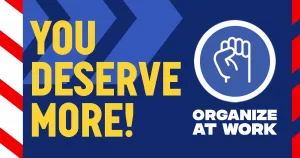Hubbub, finger-pointing, and general rancor have descended on the labor movement lately. Much of it is largely over impractical organizing strategies and what some are calling “a crisis of union leadership.” It’s worth revisiting the basic principles of what a union is and what any organizing effort should strive to be. The concept of rank-and-file unionism is our best starting place, so let’s break it down.
Engaging Workers in a Rank-and-File Union
The Emergency Workers Organizing Committee (EWOC); the United Electrical, Radio, and Machine Workers of America (UE); and the Democratic Socialists of America (DSA), recently organized a talk on how to engage workers. Jollene Levid, Bianca Cunningham, and Kari Thompson all provided an enthusiastic analysis of best practices for those committed to rank-and-file unionism.
Levid is a regional organizer with UTLA and a major driver behind the 2019 Los Angeles Teachers Strike. She made clear that organizers must be “engaging as many workers as possible, again and again, and particularly engaging workers around tough questions and decisions.” She did just that when union-wide votes on raising dues and engaging in a strike were called. She was confident that her team could make the case it was in their best interest to vote yes. By contrast, going behind members’ backs to make critical decisions about the direction of the union can be counter-productive.
Nevertheless, no one said these boots-on-the-ground organizing tactics were easy. UTLA invested heavily into research and outreach years before taking decisive action. They even developed an app to engage each of its 913 worksites, each with their own representative. Those representatives provided a headcount to UTLA organizers each day during their week-long strike. Establishing lines of communication with every worker engaged them on critical issues along the way.
UTLA’s strike vote passed with 98% of their 34,000-strong membership. Their immense display of solidarity won them a new contract within days of their strike. This victory was a clear reflection of the engaging protocols undertaken by UTLA leadership. It also ensured every worker knew the power of collective action.
Worker-Led Movements
Cunningham is the campaign director at Bargaining for the Common Good. She reiterated Jollene’s rank-and-file commitment and stressed “transparency and accountability” and “access to power is not always power.” This statement struck deep for Bianca. She’s a former Verizon worker who organized seven retail stores across Brooklyn. Those stores became the first unionized retail workers in the company.
Bianca also knows there is no secret formula that labor leaders own that ordinary workers don’t also possess. “Nothing can ever replace the power of a one-on-one conversation,” Bianca stressed. She added that there is no one better equipped to talk to employees about their rights than another worker. As a Verizon employee, Bianca was able to identify with her co-workers about specific injustices in the workplace. When she stepped out on the picket line, others knew she was risking just as much they were.
Engaging in rank-and-file unionism also tends to keep organizing leaders themselves on task. They’re constantly reminded that their work is at the behest of its members. Thompson is the director of education and international strategies at United Electrical. UE is of the few unions that has the rank-and-file motto literally written into its slogan, which she reiterated. She also explained the 2008 strike at Republic Windows and Doors, when UE Local 1110 workers illegally occupied their worksite. “We supported their choice to take that military action so that they could win,” Karrie said. UE helped them “get in contact with the media and with politicians and even with people who could bring them pizza.” In this scenario, UE worked at the behest of their local unions. Those locals took power into their own hands in order to take a quick and decisive stand.
Building a Rank-and-File Movement for the Future
Ultimately, the purpose of rank-and-file unionism is to create a more equitable future by organizing more unions. This means democratizing the ones that exist and taking more militants actions, such as strikes. (Check out the United Auto Workers referendum to adopt a one-member-one-vote system as an example.) Rank-and-file unionism means being committed to giving every worker a choice. It also means upholding transparency, the very options that employers don’t give their employees. Any union must always strive to be better than the employer.
UE is an example of how unions can put these concepts into practice. They offer local and independent unions greater autonomy, giving them the tools to bargain with employers on their own. They also maintain a right-to-strike clause in many of their contracts. This is a powerful bargaining tool and federally guaranteed right. Many workers don’t realize they are giving it away when they sign collective bargaining agreements. You can learn more about UE’s progressive governance policies.
The Union’s Inspiration
Rank-and-file unionism has also inspired several worker-led movements in the last few years. The 2019 Los Angeles teachers strike was part of a wave of teacher-led walkouts across the country, from South Carolina to Colorado. The work being done at Bargaining for the Common Good is also leveling the playing field for workers. They’re accomplishing this by involving not just public- or private-sector unions but worker centers and grassroots organizations as well.
These displays of solidarity and community-based alliances. The Fight for 15 campaign and the 2012 Chicago teachers strike both demonstrated real rank-and-file power for the working class. New groups have also formed “solidarity unions,” organizations that favor direct actions and aren’t focused primarily on collective bargaining. These groups include the Alphabet Workers Union, a minority union composed of tech workers at Google; Rideshare Drivers United; and the Tech Workers Coalition. Many of these groups’ policies are influenced by “Labor Law for the Rank and Filer” by Staughton Lynd and Daniel Gross. It’s a great resource for workers committed to self-reliance and mutual aid.
A main goal here at EWOC is to build foundational power in workplaces from the ground up. EWOC structures its organizing training and philosophy around actual workers looking to rouse their fellow employees and community members. You can learn more about their training series and read our new workplace organizing guide.




